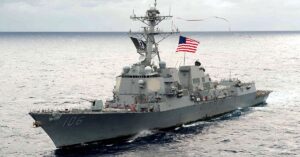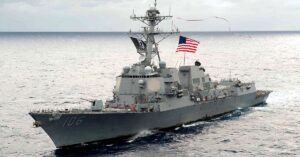
Major Emergency Declared After Cargo Ship Carrying Hazardous Materials Catches Fire In L.A. Port
November 22, 2025
Sailing Research Vessel Embarks On Scientific Mission To Antarctica’s Remote Danger Islands
November 22, 2025

A sanctioned Russian oil tanker attempting to deliver fuel to Venezuela has been forced to retreat after a United States Navy destroyer moved directly across its route near the country’s coast, according to Bloomberg vessel-tracking data reviewed on 21 November.
The tanker, Seahorse, was sailing towards Venezuela with a fuel cargo on 13 November when the USS Stockdale intersected its path just off the Venezuelan coastline.
Following the encounter, the Russian vessel abruptly reversed course towards Cuba, while the US warship continued past Venezuelan territorial waters en route to Puerto Rico.
Tracking data shows the Seahorse has made two further attempts to approach Venezuela since then, turning away on each occasion when the destroyer again appeared in its sailing corridor.
The ship is currently idling in the Caribbean with no clear progress towards any destination. The pattern is considered unusual, as Russian fuel carriers typically do not make U-turns or remain stationary on the established shipping route between Cuba and Venezuela.
US Southern Command declined to comment on the movements of the Stockdale, which has been deployed in the Caribbean since late September as part of President Donald Trump’s expanded anti-narcotics mission. The operation also includes the aircraft carrier USS Gerald R. Ford and several other Navy vessels.
The Seahorse is under sanctions imposed by the United Kingdom and the European Union and is one of four Russian tankers known to supply naphtha and other fuel products to Venezuela and Cuba.
These shipments form part of Russia’s “shadow fleet” activity, which seeks to maintain energy flows despite restrictions from Western nations.
Venezuela relies heavily on imported naphtha because much of the limited supply it produces domestically is used for gasoline production in the fuel-starved country. Although the nation has abundant oil reserves, its crude is thick and sulphurous, making diluents essential for pipeline transport.
A senior defence adviser at the Center for Strategic and International Studies in Washington was cited in reports as saying the incident appeared to be another step in the pressure the United States is applying on the Maduro government.
The adviser suggested that reduced oil exports could significantly damage the regime, as oil remains its primary source of revenue.
The Seahorse had earlier discharged a cargo in late October, called at Cuba and then headed back towards Venezuela before the US warship appeared along its route.
While Venezuela had previously received naphtha shipments from Chevron during the Biden administration, these imports have stopped under President Trump’s renewed “maximum pressure” policy on Caracas. As a result, the country now depends on Russian deliveries.
In a separate development, Russia’s Foreign Minister Sergey Lavrov stated earlier that Moscow did not plan to provide military assistance to Venezuela.
Reference: Bloomberg
Source: Maritime Shipping News


